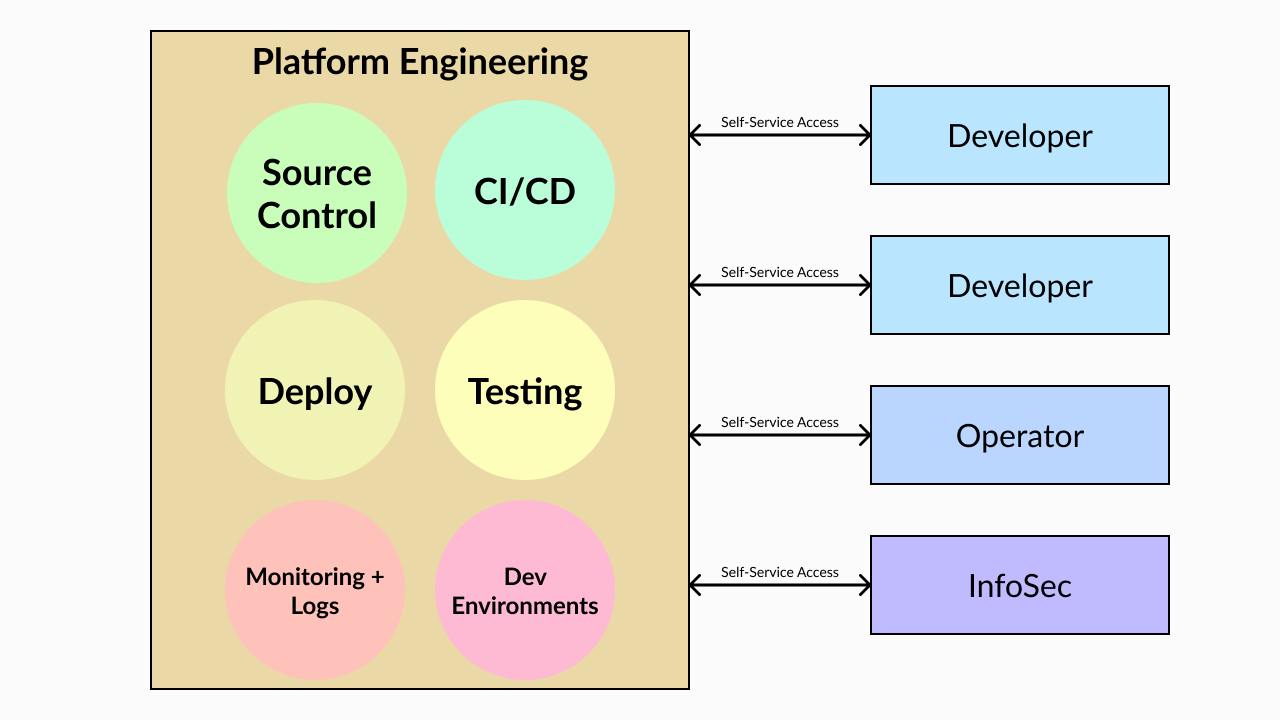Platform Engineering, What It’s For, and How to Get It Right
Introduction to an effective way to streamline software development and get more value out of your developer team

Platform engineering is the practice of building tools and systems for internal use by software development teams. Platform engineers’ goal is to improve developer productivity by creating a self-service platform that automates common tasks.

Companies that invest in effective platform engineering usually get higher engineering throughput as a result of a simpler developer experience. They also find it easier to onboard new engineers. In this article, you'll learn how platform engineering fits into the modern software development process and what key characteristics effective internal platforms have.
More on platform engineering:
- How to Win at Platform Engineering
- How to Build a Platform Team (And Why You Need One)
- Which Internal Developer Portal Will 10x Your Team’s Output?
Differences Between Platform Engineering, SRE and DevOps
Platform engineering is a relatively new practice in the software development lifecycle (SDLC). It sits alongside established concepts such as DevOps and SRE, but has a focus on internal tooling:
- DevOps is a cultural methodology that seeks to shorten software delivery feedback loops by integrating and automating development and operations tasks.
- Site Reliability Engineering (SRE) is the practice of automating IT infrastructure operations using software development-derived methods. SRE is designed to maximize system reliability and scalability.
- Platform Engineering is all about supporting developer productivity by providing internal tools that are tailored to your products, systems and processes.
High-performing software teams use DevOps, SRE and platform engineering to achieve tight feedback loops that maximize productivity without sacrificing reliability. Platform engineering is often overlooked, but it can be one of the most effective ways to make existing teams more productive.
| DevOps | SRE | Platform Engineering | |
|---|---|---|---|
|
Scope of work |
Implementing and managing the overall SDLC |
Implementing tools and processes to support reliability and scalability |
Providing effective internal tooling for development teams |
|
Goals/responsibilities |
Configuring CI/CD pipelines, observability suites and infrastructure |
Managing infrastructure uptime, incident response and performance |
Ensuring developers are supported by tools that maximize productivity |
| Outcomes |
A tight software delivery feedback loop that makes maximum use of automation |
Reliable, scalable infrastructure that minimizes downtime |
Improved developer tooling |
What's the Big Deal About Platform Engineering?
Platform engineering to a degree simplifies the SDLC. For instance, internal platforms that can automate key tasks (such as setting up a new staging environment or provisioning a fresh database instance) allow developers to spend more time working on what matters—usually authoring new code.
Large organizations often struggle to consolidate toolchains and processes, particularly when individuals might be connecting from multiple devices and locations. This also makes it harder to onboard new staff, since there might not be an easy way to set up a new development environment or grant access to the required infrastructure.
Internal platforms solve these issues through centralization. They provide developers with self-service access to these workflows, thus accelerating the development process and making it more consistent. This also reduces the risk of security oversights and misconfigurations. Higher throughput and a simpler, more satisfying experience for everyone connected to the project are what success looks like in platform engineering.
Because platform engineering usually requires a dedicated team, some see it as a waste of resources. Historically, developers have been expected to build any tools they need while doing their other work. But we don't expect a train driver to also maintain the train! In the same way that a depot's maintenance staff allows drivers to focus on their core responsibilities, platform engineers provide developers with the resources they need to contribute maximum value to the team.
What Is a ‘Platform’ in the Context of Platform Engineering?
The platforms created by platform engineering teams are usually termed "internal developer platforms" (IDPs). You can think of them as private platform-as-a-service (PaaS) solutions that are purpose-built for your apps and processes.
Every organization has its own needs, so IDP implementations differ from one to another somewhat in functionality. What’s common between them is their purpose: to centralize and catalog systems, tools and data that developers require to do their work. Those are the areas all IDP platforms should be focused on.
Some capabilities frequently found in IDPs include:
- Source repository management services (e.g. opening a pull request in a consistent format)
- Access to generated assets, such as build outputs, log files and traces
- Deployment and release capabilities, such as publishing a release, generating its changelog and notifying customers
- On-demand security and compliance scans that detect vulnerabilities, hard-coded secrets, misconfigurations and other threats in work-in-progress code
- Provisioning of new development environments that closely match production
Developers typically interact with IDPs using a combination of APIs, CLIs and web-based portals that provide access to the platforms’ capabilities. It's also useful for IDPs to directly integrate with your development tools. For example, you could set up a procedure that deploys code to a fresh staging environment when engineers submit GitHub pull requests.
Key Components of a Robust Internal Platform
IDPs are designed to maximize software delivery throughput. To ensure this happens, platforms must be robust enough to support all current and future development requirements. Here are five key characteristics that IDPs should include.
1. Scalability
Platforms need to scale as your teams and asset inventories grow. A platform that ends up constraining developers could harm throughput, so you must design your architecture to support all the infrastructure types, cloud providers and applications you'll be using.
Platform engineering teams should be responsible for regularly maintaining the platform and implementing any improvements that will help it scale. For example, this could include moving the platform onto more resilient infrastructure or creating new in-platform services to support collaboration and training as development teams grow.
2. Security
IDPs have to be uncompromisingly secure. Because IDPs integrate with your source code repositories, CI/CD services and external cloud accounts, any vulnerability could be disastrous for your entire development system.
Securing an IDP is similar to protecting any other type of software. You should enforce correct access controls, use secure authentication methods (such as MFA) and implement auditing tools and vulnerability scanners to find and fix potential issues.
IDPs provide the advantage of a known audience: since the only people interacting with your platform should be your developers, you might not need to expose the platform publicly. If you do require remote access for a distributed workforce, a VPN solution can help.
3. Cost Efficiency
Proposals to launch IDPs are often met with resistance because of the extra cost. Maintaining IDP infrastructure and hiring a platform engineering team can be expensive, but that’s only if requirements aren't clearly defined or costs aren’t properly controlled.
An IDP is cost efficient when it meaningfully improves developer productivity. One way of ensuring this is to choose simple solutions that solve actual developer requests instead of building complex tools that go unused. You should also select the most cost-efficient infrastructure solution to host your platform, whether in a public cloud, in a dedicated cloud or on premises.
Depending on your organization's size, you might not need a full-time platform engineering team. Part-time platform engineering efforts can still deliver meaningful improvements to the developer experience while allowing those engineers to be redeployed to product development during times of platform stability.
4. Compliance
IDPs can affect your compliance with the standards and frameworks you're governed by. For example, a platform that provides too much self-service access to developers could expose sensitive data or allow unaudited changes to be made to live environments.
The flip side is that centralizing developer tools into platforms also provides opportunities to improve compliance. Ensuring all processes are carried out using the platform guarantees that you can record audit events and block potentially problematic actions. It's important to keep the platform engineering team informed of changing requirements so that appropriate controls can be implemented.
5. Flexibility
IDPs should ultimately provide DevOps teams with greater flexibility. This applies to tools (by integrating with all the IDEs that developers use, for instance) as well as working methods. For example, platforms are good enablers of remote and hybrid work because they automate complex processes that might otherwise only be possible on a networked workstation in the office.
Flexibility also means the platform should be open to change. New tools, projects and teams will likely appear in the future, often with their own working methods and deployment techniques. An effective platform should be able to accommodate asset inventory additions with minimal work required from individual developers. Designing the platform for automation, templating and customization will deliver this capability.
To sum it all up, platform engineering is a way to streamline software development by creating internal self-service platforms that automate key tasks. This allows developers to focus on more meaningful work, ultimately delivering more value for the organization.
Successful platforms must be flexible and scalable enough to support your development operations without compromising on security or compliance. This requires platforms to support all the technologies you're using, including hybrid and on-prem environments, in addition to your cloud resources.
One good way to get maximum control and flexibility is to deploy it on a dedicated cloud, such as Equinix’s. It enables you to remotely spin up bare metal servers at the edge, in key metropolitan areas, at global scale and connect them privately to any network provider or major cloud platform, so that your developers can leverage all the powerful public cloud tools. The dedicated cloud service includes advanced virtual networking capabilities, so you can set up the routers, firewalls and load balancers you need to facilitate secure and stable platform access. Experience it for yourself free of cost with a $250 credit for first-time users.

Ready to kick the tires?
Use code DEPLOYNOW for $300 credit